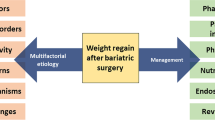Abstract
Background
Obesity is a leading cause of morbidity and healthcare utilization. At the moment, the best treatment for obesity has shown to be laparoscopic gastric bypass. However, about a quarter of the patients experience substantial weight regain, which is difficult to treat, as revision surgery has higher risks than primary procedures. Endoscopic procedures, such as endoscopic suturing, are effective, safe and less invasive in addressing weight regain.
Methods
We conducted a retrospective analysis on 22 consecutive patients operated between 2011 and 2013 who had a significant weight regain after RYGB (mean follow-up 22 months), in order to evaluate the long-term outcomes of endoscopic gastro-jejunal revision after weight regain post-bypass surgery. Mucosal ablation around the anastomosis was performed in all patients, and the endoscopic suturing device was used to perform suture stoma reduction. We also evaluated, in a group of 11 patients, the effect of combining sclerotherapy and endoscopic suturing.
Results
We showed good efficacy of the endoluminal procedure, with 100 % of patients achieving weight loss. Maximum weight loss was noted at a mean of 18-month follow-up (average of 60.3 % excess weight loss; n = 19), while the mean weight loss regained percentage was 5 % ± 39. 4/22 patients (all four in non-sclerotherapy group, all of them had an anastomosis >10 mm) regained some of this lost weight by the time of the longest follow-up. There was an actual correlation between final stoma diameter (<10 mm) and weight loss.
Conclusions
A larger randomized sample of patients with a longer follow-up would be needed to support the effectiveness of the combination of the two therapies. Although almost 20 % of the patients regained weight during the follow-up period, the endoluminal approach offers the advantage of being repeatable after weight regain without adding morbidity risks.



Similar content being viewed by others
References
NIH, N. I. O. H. National Institutes of Health (1998) Clinical guidelines on the identification, evaluation, and treatment of overweight and obesity in adults—the evidence report. s.l. Obes Res
WHO (2000) Obesity: preventing and managing the global epidemic: report of a WHO consultation. s.l. World Health Organ Tech Rep Ser
Castro A, Kolka CM, Kim SP, Bergman RN (2014) Obesity, insulin resistance and comorbidities—mechanisms of association. Arq Bras Endocrinol Metabol 58(6):600–609
Sjöström L, Lindroos AK, Peltonen M, Torgerson J, Bouchard C, Carlsson B, Dahlgren S, Larsson B, Narbro K, Sjöström CD, Sullivan M, Wedel H (2004) Lifestyle, diabetes, and cardiovascular risk factors 10 years after bariatric surgery. New Engl J Med 351(26):2683–2693
Mullady DK, Lautz DB, Thompson CC (2009) Treatment of weight regain after gastric bypass surgery when using a new endoscopic platform: initial experience and early outcomes. Gastrointest Endosc 70(3):440–444
Gagner M, Gentileschi P, de Csepel J, Kini S, Patterson E, Inabnet WB, Herron D, Pomp A (2002) Laparoscopic reoperative bariatric surgery: experience from 27 consecutive patients. Obes Surg 12(2):254–260
Khaitan L, Van Sickle K, Gonzalez R, Lin E, Ramshaw B, Smith CD (2005) Laparoscopic revision of bariatric procedures: Is it feasible? Am Surg 71(1):6–10
Hallowell PT, Stellato TA, Yao DA, Robinson A, Schuster MM, Graf KN (2009) Should bariatric revisional surgery be avoided secondary to increased morbidity and mortality? Am J Surg 197(3):391–396. doi:10.1016/j.amjsurg.2008.11.011
Hii MW, Lake AC, Kenfield C, Hopkins GH (2012) Laparoscopic conversion of failed gastric banding to Roux-en-Y gastric bypass. Short-term follow-up and technical considerations. Obes Surg 22(7):1022–1028. doi:10.1007/s11695-012-0594-3
Thompson CC, Chand B, Chen YK, Demarco DC, Miller L, Schweitzer M, Rothstein RI, Lautz DB, Slattery J, Ryan MB, Brethauer S, Schauer P, Mitchell MC, Starpoli A, Haber GB, Catalano MF, Edmundowicz S, Fagnant AM, Kaplan LM, Roslin MS (2013) Endoscopic suturing for transoral outlet reduction increases weight Q2 loss after Roux-en-Y gastric bypass surgery. Gastroenterology 145(1):129–137. doi:10.1053/j.gastro.2013.04.002
Woods KE, Abu Dayyeh BK, Thompson CC (2010) Endoscopic post-bypass revisions. Tech Gastrointest Endosc 12(3):160–166
Spaulding L, Osler T, Patlak J (2007) Long-term results of sclerotherapy for dilated gastrojejunostomy after gastric bypass. Surg Obes Relat Dis 3(6):623–626
Loewen M, Barba C (2008) Endoscopic sclerotherapy for dilated gastrojejunostomy of failed gastric bypass. Surg Obes Relat Dis 4(4):539–542
Ma P, Reddy S, Higa KD (2016) Revisional bariatric/metabolic surgery: What dictates its indications? Curr Atheroscler Rep. doi:10.1007/s11883-016-0592-3
Author information
Authors and Affiliations
Corresponding author
Ethics declarations
Disclosures
Drs. Riva and Perretta have no conflict of interest or financial ties to disclose. Dr Swanstrom serves on the scientific advisory board of Apollo Medical and has no other conflicts to declare.
Rights and permissions
About this article
Cite this article
Riva, P., Perretta, S. & Swanstrom, L. Weight regain following RYGB can be effectively treated using a combination of endoscopic suturing and sclerotherapy. Surg Endosc 31, 1891–1895 (2017). https://doi.org/10.1007/s00464-016-5189-y
Received:
Accepted:
Published:
Issue Date:
DOI: https://doi.org/10.1007/s00464-016-5189-y




